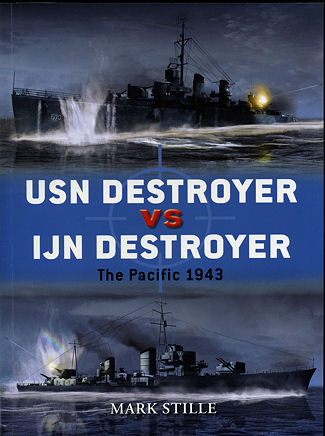 Like many
things in war, things changed in the naval war in the Pacific. Japan entered the
war with relatively large, well equipped destroyers and equally well trained
crews. They had not only the tactical advantage, but an advantage in equipment
as well, with the superb type 93 torpedo, a weapon that had outstanding speed
and range.
Like many
things in war, things changed in the naval war in the Pacific. Japan entered the
war with relatively large, well equipped destroyers and equally well trained
crews. They had not only the tactical advantage, but an advantage in equipment
as well, with the superb type 93 torpedo, a weapon that had outstanding speed
and range.
On the other hand, the USN was saddled with a torpedo that
was not reliable and that was limited in range. In addition, US destroyers were
tactically deployed differently than those of the IJN. The US did not use
destroyers as a striking arm the way the Japanese did, preferring to use them in
concert with larger ships. As part of the US destroyer captain's mission was to
protect the larger vessels, they were not as aggressively used. The results in
early battles in the Solomons proved this as the superior night fighting
abilities and optics of the Japanese frequently out-weighed the US radar
advantage. Add to this that US intelligence had not realized just how potent a
weapon the Japanese Type 93 torpedo actually was. Many an Allied ship was sunk
by these torpedo and it was not until early 1944 that the USN was able to
provide information to its fleet commanders and captains on the specifics of
this weapon.
This book concentrates on the last of the destroyer vs
destroyer battles fought in 1943. It was during this time that US destroyer
captains were able to develop tactics that were successful against the Japanese.
Of the four battles covered in the book, you can see the switch in advantage
from the Japanese to the US. Much of this is thanks to Arleigh Burke who was
able to not only develop these tactics, but convince the fleet commanders that
this was the way to go. Even when his theories were used in a modified form, the
results were success that was not obtained earlier.
The book goes into some detail of the various tactical uses
of the destroyer as well as the weapons and other systems used by both sides.
Both US and Japanese destroyers themselves are covered, though due to the large
number, not as much space is provided to each class of ship as a dedicated book
on the types would provide. The plusses and minuses of each class of ship are
looked into during this section. The final part of the book covers the last four
destroyer fleet actions of the Pacific War; Vella Gulf, Horaniu, Vella Lavella,
and Cape St. George. After this, the Japanese destroyer fleet had become so
depleted, that these sorts of actions were no longer possible.
In all, it makes for a superb title in the Duel series. It is
a great read and tells a lot about how naval tactics changed for the combatants
as the war progressed. It is a book I thoroughly enjoyed reading and is one you
can purchase with confidence.
December 2012
For more on the complete line of Osprey books,
visit www.ospreypublishing.com. In the US, it is
Osprey Direct at 443 Park Avenue South, New York, NY 10016, where you can
get a catalogue of available books.
If you would like your product reviewed fairly and quickly, please contact
me or see other details in the Note to
Contributors.
 Like many
things in war, things changed in the naval war in the Pacific. Japan entered the
war with relatively large, well equipped destroyers and equally well trained
crews. They had not only the tactical advantage, but an advantage in equipment
as well, with the superb type 93 torpedo, a weapon that had outstanding speed
and range.
Like many
things in war, things changed in the naval war in the Pacific. Japan entered the
war with relatively large, well equipped destroyers and equally well trained
crews. They had not only the tactical advantage, but an advantage in equipment
as well, with the superb type 93 torpedo, a weapon that had outstanding speed
and range.